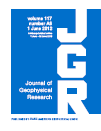
JOURNAL OF GEOPHYSICAL RESEARCH-SPACE PHYSICS
Scope & Guideline
Unveiling the Mysteries of the Ionosphere and Magnetosphere
Introduction
Aims and Scopes
- Magnetosphere Dynamics:
This area encompasses studies on the structure, dynamics, and interactions of the Earth's magnetosphere with solar wind and cosmic phenomena, including magnetic reconnection, flux transfer events, and the response of the magnetosphere to solar activity. - Ionospheric Variability:
Research focuses on the behavior of the ionosphere under various geomagnetic conditions, including the impact of solar flares, geomagnetic storms, and seasonal changes on ionospheric density, electron content, and irregularities. - Planetary Atmospheres and Magnetospheres:
Investigations into the atmospheres and magnetospheric environments of other planets, such as Mars and Jupiter, exploring their unique interactions with solar wind and their respective magnetic fields. - Wave-Particle Interactions:
This includes studies on the interactions between various plasma waves (e.g., whistler waves, EMIC waves) and charged particles, which are crucial for understanding energy transfer processes and particle dynamics in space. - Space Weather Impacts:
Research related to space weather phenomena and their effects on technology, communication, and navigation systems on Earth, focusing on the predictive capabilities and modeling of space weather events.
Trending and Emerging
- Machine Learning Applications:
The use of machine learning techniques for analyzing large datasets and improving predictive models has gained momentum. This trend reflects a broader push towards data-driven approaches in space physics research. - Multi-Instrument and Multi-Satellite Observations:
There is a growing emphasis on coordinated observations from various instruments and satellites to capture complex phenomena in the magnetosphere and ionosphere, enhancing the quality and comprehensiveness of research findings. - Real-Time Monitoring and Predictive Modeling:
The journal is increasingly publishing studies focused on real-time monitoring of space weather events and predictive modeling, reflecting a growing need for timely data to mitigate the impacts of space weather on technology and infrastructure. - Planetary Magnetospheres and Atmospheres:
Research into the magnetospheres and atmospheres of other planets, especially Mars and Jupiter, is on the rise. This includes studies on atmospheric escape processes, magnetospheric dynamics, and their implications for habitability and exploration. - Interdisciplinary Approaches to Space Weather:
There is a notable trend towards interdisciplinary research that combines space physics with other fields such as geology, meteorology, and climate science to understand the broader implications of space weather events.
Declining or Waning
- Static Models of Magnetospheric Interactions:
Older models that do not account for dynamic changes in the magnetosphere and ionosphere have decreased in prevalence. The focus has shifted towards more adaptive and real-time models that can incorporate variability in solar wind and geomagnetic conditions. - Simple Correlation Studies:
While correlation studies provided valuable initial insights, there has been a marked decline in their frequency as the field moves towards more complex modeling techniques that integrate multiple variables and advanced simulations. - Historical Data Analysis in Isolation:
Research based solely on historical datasets without integrating modern observational techniques or models has become less common. The trend favors studies that combine past data with current observations to provide a more comprehensive understanding of space weather phenomena.
Similar Journals
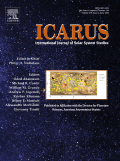
ICARUS
Pioneering Insights into Planetary Processes and Space Exploration.ICARUS is a prominent peer-reviewed journal dedicated to advancing knowledge in the realm of Astronomy and Astrophysics, as well as Space and Planetary Science. Published by Academic Press Inc, Elsevier Science, this esteemed journal has been contributing to the scientific discourse since 1962 and will continue to do so well into 2024. With an impressive impact factor placing it in the Q2 quartile, ICARUS ranks among the top journals in its field, standing appropriately at #22 out of 90 in Astronomy and Astrophysics and #27 out of 104 in Space and Planetary Science according to Scopus metrics. Researchers, professionals, and students alike benefit from its comprehensive scope, which encompasses a wide array of topics related to planetary processes, space exploration, and astrophysical phenomena. Although it does not currently offer open access, the journal remains a critical resource for scholars seeking to disseminate their findings and engage with cutting-edge research in the exciting fields of astronomy and planetary science.
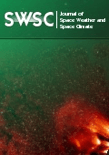
Journal of Space Weather and Space Climate
Advancing Knowledge: Your Gateway to Space Weather ResearchThe Journal of Space Weather and Space Climate is a premier, internationally recognized open-access journal published by EDP Sciences S A, dedicated to advancing the understanding of the intricate interactions between solar and geophysical phenomena. With an ISSN of 2115-7251, this journal has been at the forefront of research since 2011, fostering discussions and disseminating findings related to atmospheric and planetary sciences. The journal ranks in the top quartile for both Atmospheric Science and Space and Planetary Science, highlighting its critical role in the academia with Scopus rankings placing it at #24 out of 104 in Space and Planetary Science and #35 out of 148 in Atmospheric Science. Based in France, it offers seamless access to cutting-edge research, motivating researchers, professionals, and students to contribute to the growing knowledge in this vital field. The journal's commitment to open access ensures that impactful research reaches an extensive audience, promoting collaborative efforts to tackle issues related to space weather and climate change.

SOLAR SYSTEM RESEARCH
Navigating the Complexities of Our Solar SystemSOLAR SYSTEM RESEARCH, published by Pleides Publishing Inc, offers a comprehensive platform for the exploration and dissemination of scientific knowledge in the fields of Astronomy, Astrophysics, and Space and Planetary Science. With its origins tracing back to 1969, this journal provides a vital resource for researchers and professionals seeking to deepen their understanding of the solar system's complexities, including planetary formation, extraterrestrial geology, and the dynamics of celestial bodies. Although categorized in the Q4 quartile for both relevant disciplines, SOLAR SYSTEM RESEARCH remains committed to publishing high-quality research that contributes to advancing contemporary scientific discourse. Dedicated to fostering collaboration and innovation, the journal is indexed in Scopus and adheres to rigorous academic standards, making it an essential resource for students and professionals alike pursuing the latest developments in solar system studies.

GEOMAGNETISM AND AERONOMY
Innovating Research in Geomagnetism and AeronomyGEOMAGNETISM AND AERONOMY, published by MAIK NAUKA/INTERPERIODICA/SPRINGER, is a prominent journal dedicated to advancing the fields of geophysics and planetary science. With ISSN 0016-7932 and E-ISSN 1555-645X, this journal serves as a critical platform for researchers to disseminate their findings on geomagnetic phenomena and aeronomical studies, fostering a deeper understanding of Earth's magnetic field dynamics and atmospheric interactions. Spanning publishing years from 1996 to 2024, it is categorized in the Q3 quartile for geophysics and Q4 for space and planetary science, reflecting its positioning within the academic landscape. Although not open access, readers and researchers can access valuable insights into geomagnetic and atmospheric research, contributing to ongoing discourse in these vital scientific domains. With a focus on innovative research, GEOMAGNETISM AND AERONOMY remains an essential resource for professionals and students aiming to deepen their expertise in Earth and planetary sciences.
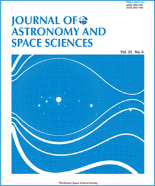
Journal of Astronomy and Space Sciences
Pioneering Insights into the Mysteries of Space.The Journal of Astronomy and Space Sciences, published by the Korean Space Science Society, is a premier open-access platform dedicated to advancing the fields of astronomy, astrophysics, and space sciences. Established in 1984, the journal has been instrumental in disseminating high-quality research findings, fostering collaboration among scientists globally, and providing insights into the dynamics of our universe. With an ISSN of 2093-5587 and an E-ISSN of 2093-1409, the journal has gained notable recognition, currently ranking in the Q3 quartile in Earth and Planetary Sciences and Physics and Astronomy as of 2023. Although the journal's H-Index is currently unspecified, its commitment to rigorous peer-review processes and open-access availability ensures that groundbreaking research is accessible to a wide audience. Based in Seoul, South Korea, the journal is poised to continue supporting innovative research through 2024 and beyond. Researchers, professionals, and students alike will find valuable resources and opportunities within its pages, further establishing this journal as a crucial resource in the exploration of the cosmos.

COSMIC RESEARCH
Advancing Knowledge in Aerospace and AstronomyCOSMIC RESEARCH is a prestigious academic journal dedicated to advancing the field of space science, particularly within the domains of aerospace engineering, astronomy, and planetary science. Published by MAIK NAUKA/INTERPERIODICA/SPRINGER, this journal has been a significant contributor to the scholarly discourse since its inception in 1968, with converged years showing robust publication activity until 2024. With a Q4 category ranking in various disciplines, including aerospace engineering, astronomy, and space science, the journal serves as a platform for disseminating innovative research and comprehensive reviews. Although not currently offering open access, COSMIC RESEARCH is renowned for its rigorous peer-review process, ensuring that only high-quality research is shared with the academic community. The journal's ISSN is 0010-9525 and its E-ISSN is 1608-3075. Researchers, professionals, and students alike can benefit from the insights and findings presented in this journal, making it an essential resource for anyone involved in the exploration of cosmic phenomena.

Kinematics and Physics of Celestial Bodies
Advancing Knowledge in Astronomical PhysicsKinematics and Physics of Celestial Bodies is a prominent journal published by PLEIADES PUBLISHING INC, dedicated to the exploration and understanding of celestial mechanics and the physical properties of astronomical bodies. With an ISSN of 0884-5913 and an E-ISSN of 1934-8401, this journal has established itself as a resource for researchers in the fields of astronomy, astrophysics, and space science since its inception in 2009. The journal is indexed in Scopus, where it currently ranks in the fourth quartile for both Astronomy and Astrophysics and Space and Planetary Science, making it a valuable platform for scholarly discourse despite its ranking. Its scope encompasses a range of topics related to the kinematics and physical characteristics of celestial objects, aiming to facilitate a better understanding of their dynamics and interactions within the universe. Although it does not operate under an open access model, the journal provides essential insights and findings, catering to the academic needs of researchers, professionals, and students engaged in the study of the cosmos. The journal's commitment to advancing knowledge in the various aspects of celestial physics ultimately contributes to the broader scientific community's endeavors.

Earth and Planetary Physics
Connecting Global Scholars in Earth and Planetary PhysicsEarth and Planetary Physics, published by SCIENCE PRESS, is a distinguished open-access journal that has been a vital resource for the scientific community since its inception in 2017. With both ISSN and E-ISSN 2096-3955, this journal contributes significantly to the fields of Astronomy and Astrophysics, Atmospheric Science, and Space and Planetary Science, consistently holding a Q2 quartile ranking across these categories as of 2023. Based in the United States, its editorial board consists of renowned experts dedicated to advancing the understanding of planetary phenomena and Earth processes. The journal prides itself on its rigorous peer-review process and broad readership, facilitating the dissemination of cutting-edge research and innovative methodologies. This commitment is reflected in its strong Scopus rankings, positioning it competitively within its scope—rank #33 in Astronomy and Astrophysics and rank #40 in Space and Planetary Science. As an open-access journal, Earth and Planetary Physics is committed to providing free and global access to high-quality research, thereby enhancing visibility and impact for its authors while catering to researchers, professionals, and students eager to explore the intricacies of our planet and beyond.

EARTH PLANETS AND SPACE
Bridging Earth Sciences and Cosmic PhenomenaEARTH PLANETS AND SPACE, published by Springer and based in Switzerland, is a distinguished journal that plays a pivotal role in advancing the fields of Earth and planetary sciences. With an impactful presence in both geology (Q1) and space and planetary science (Q2), this journal is increasingly recognized for its contributions to understanding complex geoscientific processes and extraterrestrial phenomena. The journal has been a vital resource for researchers since its inception in 1996 and is anticipated to continue this legacy until at least 2024. It ranks impressively within the Scopus database, holding the 53rd position out of 321 in Earth and Planetary Sciences for Geology and the 30th position out of 104 for Space and Planetary Science, reflecting a robust percentile standing of 83 and 71, respectively. With open access options available, EARTH PLANETS AND SPACE makes cutting-edge research more accessible to a global audience, fostering collaboration and innovation. This journal is essential for anyone seeking to deepen their knowledge or stay current with trends in Earth sciences and planetary exploration.
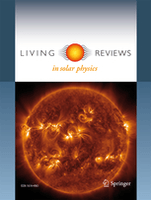
Living Reviews in Solar Physics
Transforming Solar Research through Open AccessLiving Reviews in Solar Physics is a premier open access journal published by Springer International Publishing AG, dedicated to the dynamic field of solar physics. Since its inception in 2004, this journal has provided a platform for comprehensive and up-to-date reviews that cover the latest developments in solar research, making it an invaluable resource for researchers, professionals, and students alike. With an impressive Q1 ranking in both Astronomy and Astrophysics and Space and Planetary Science as of 2023, it ranks in the top 3% of journals in its field according to Scopus. The journal's commitment to open access ensures that groundbreaking research is disseminated widely, fostering collaboration and innovation. As it continues to evolve through to its converged years from 2004 to 2024, Living Reviews in Solar Physics remains a crucial outlet for advancing our understanding of solar phenomena and their implications for astrophysics and planetary science.